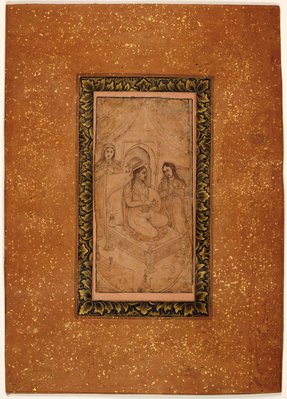-
Details
- Other Title
- A mistress dressed in European costume attended by two maidens
- Place where the work was made
-
India
- Period
- Provincial Mughal circa 1748 - circa 1860 → India
- Date
- early 18th century
- Media category
- Painting
- Materials used
- ink and wash on gazelle skin on card
- Dimensions
- 16.8 x 8.4 cm image; 33.3 x 23.5 cm sheet
- Credit
- Gift of Dr Jim Masselos 2022
- Location
- Not on display
- Accession number
- 22.2022
- Copyright
- Share
-
-
About
After the Mughal Emperor Akbar (r. 11 Feb 1556- 27 Oct 1605) conquered the port city of Surat on the west coast of India in 1573 he was brought into close contact with European traders who were operating in the city and further down the coast in Goa. Akbar made contact with the Portuguese viceroy at Goa and asked him to facilitate the travel of Christian religious scholars to India so that he could learn about their faith. When Jesuit fathers arrived at the Mughal courts, they frequently bought paintings and prints with them as gifts for the emperor. Akbar and his son, Prince Salim (later known as Jahangir) commissioned many copies of the European paintings and prints. In fact, it even became popular for paintings, like this one, to be made with ink and slight hints of colour to imitate the handmade and generally monochromatic prints.1.
Although portraits of the royal ruler and his associates were among the most popular of all Indian painting commissions, queens and princesses were also the subjects of portraits. However, the other women of the court were more frequently shown in the context of formulaic scenes were individuals and groups of women were shown at rest or leisure in their quarters. Because this type of painting was regularly commissioned by a male patron these scenes often conveyed a sense of idleness and longing, inferring that the women depicted were in need or were awaiting a male companion. Likewise, images of women dressing, bathing or dancing were designed for the pleasure of men. Due to Akbar’s interest in European ideas, painting and fashion it is not uncommon to see Mughal court scenes that include aspects of European life and fashion, such as the feathered bonnet worn by the main subject of this painting.
1.Kavita Singh, Real birds in imagined gardens. Mughal paintings between Persia and Europe, Getty Research Institute Council Lecture, 2017, pp 21- 26.
-
Places
Where the work was made
India
-
Bibliography
Referenced in 1 publication
-
Sotheby's spring Islamic sales. Catalogue of oriental manuscripts and miniatures., London, 16 Apr 1984, 18. lot. 27
-
-
Provenance
Jim Masselos, 1984-2022, Sydney/New South Wales/Australia, purchased from Sotheby's sale 16/4/1984. Donated to the Art Gallery of New South Wales, Sydney, April 2022.
Sotheby's London, 16 Apr 1984, London/England, offered for sale.

